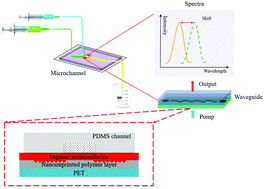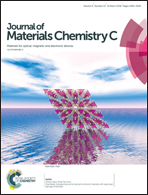Microfluidic channels incorporating organic distributed Bragg reflector lasers for in situ sensing applications†
Abstract
The in situ sensing capabilities of organic distributed Bragg reflector (DBR) laser sensors are demonstrated by exploiting the operation advantages of microfluidic channels. As an active cavity sensor that utilizes the narrow lasing peak as the detecting light, this novel in situ sensor features not only high sensitivity and high resolution, but also has advantages of low sample volume requirement, high temporal resolution and low cost. The device parameters are optimized using a multi-layer waveguiding model in terms of detection sensitivity and laser threshold. The economical, integrated and well-aligned organic DBR lasers by dot-matrix holography are incorporated into the microfluidic channels by using PVA as a bonding interlayer. Owing to the operation convenience, the detection capabilities are verified in terms of various physico-chemical processes including the refreshment of different fluids, the dynamical dissolution of glucose solution into variable concentrations and the real-time monitoring of the diffusion process. This work corroborates the in situ detection possibility of organic DBR lasers incorporating microfluidic channels as an active cavity sensor; and it simultaneously paves the way to disposable microfluidic lab-on-chips for various detection applications.



 Please wait while we load your content...
Please wait while we load your content...